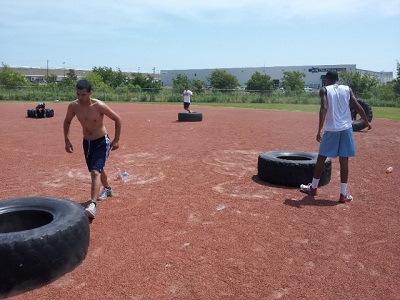IYCA Expert Dave Gleason Explains How To Develop Youth Conditioning Programs Using Unconventional Methods
As long as your programming has developmental justification that points pack to the required elements of the IYCA system…everything is in bounds!
This includes tires and battle ropes. Many of our AR franchise partners are co branded or are also a Fitness Revolution Franchisee as well. That said, many of our trainers and coaches have experience with large tractor tires and battle ropes. With safety mechanisms in place, very effective and fun activities can be implemented in your youth conditioning programs for 6-9 (Discovery) and 10-13 (Exploration) sessions.
Here are a few examples of youth conditioning programs to get your creative juices flowing:
1. Team Tire Flip.

Even with a 500+ pound tire if you orientate your young athletes well and put yourself in a position to effective spot this activity, this is a very safe team building and exercise. Systemic strength, object manipulation, and cooperation are all aspects of this fun drill.
Have your athletes form a semi circle around the backside of the tire. Cue them to keep their toes close to the tire, and keep their eyes up as they place their hands underneath the tire. “On a count of three we all lift and drive the tire forward.”
2. Team Tire Drag (Pull).
This systemic strength pulling activity is an adventurous variation of tug o war.
Place a battle rope through the middle of a large tire so there are two equal lengths of rope to pull on. Place your athletes evenly on each length of rope. On your command your athletes will pull and drag the tire to a designated area or length.
You can add variation and problem solving by experimenting with how many athletes you can take off of pulling duties to sit on the tire with the remaining athletes still able to move the tire. Then experiment with different kids on the tire vs. pulling.

3. Angry Monkeys.
This super fun exercise is a battle rope wave drill masked by as silly name and animation during the movement. Straight from the brain of Autism Fitness Expert, Eric Chessen, the set up virtually the same depending on the age and size of the athletes. Your 6-9 year old athletes will do well with a single rope wave. A mature 12 or 13 year old will handle a rope end in each hand with no problem. A 40 foot, 1.5 inch in diameter, rope works very well.
Instruct your athletes to act like an angry monkey with the rope end in their hands while making a wave in the rope. Let them make “angry monkey” noises. 10-20 seconds of work is optimal depend on the age of the athletes in your group.
4. Battle Rope Relay.

Object manipulation, cooperation, spatial awareness systemic strength and kinesthetic differentiation are included in the benefits of this game.
Lay out a battle rope in a straight line on the ground. Form two lines of athletes, one line at each end of the rope. The first athlete in each line grabs hold of the end of the rope like a relay baton. On your command the athletes race to opposites ends and hand the rope off to the next person in line.
This is a perpetual race because there is no winner. Give your athletes 2-3 runs each and then give the group a rest.

When ever you can think out of the box and apply some additional fun and adventure into your Youth Conditioning Programs for young athletes you should do so! If something is working well for you please share in in the IYCA Insiders Forum.
Keep changing lives!


